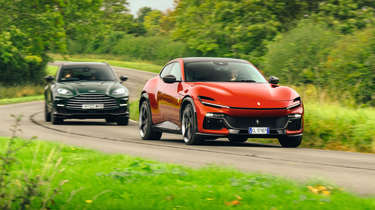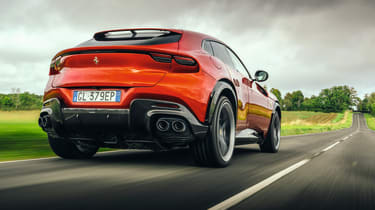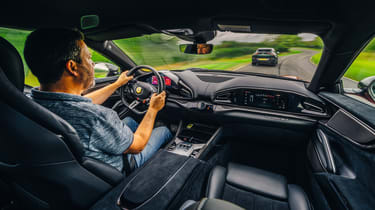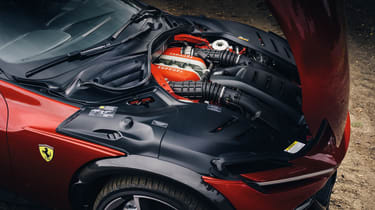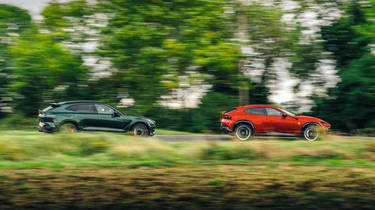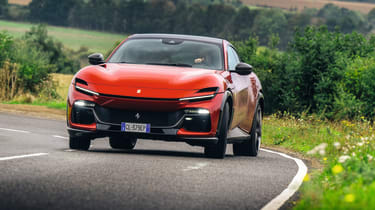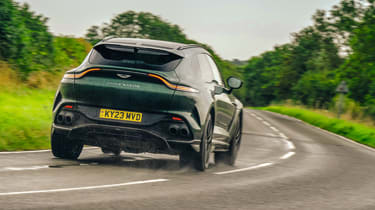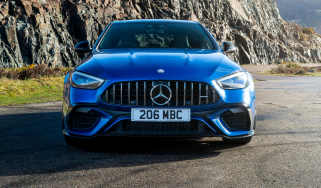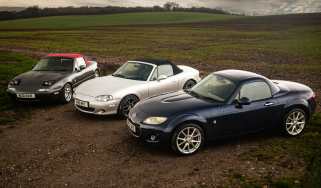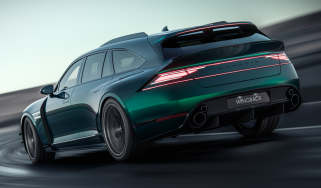Aston Martin DBX707 v Ferrari Purosangue – flagship super SUVs go head-to-head
Everything about them is supersize, from their kerb weights to their power outputs. But they’re also hugely enjoyable – and quite different in character. So which provides the bigger thrill?
The DBX707 and Purosangue are the cars we should hate. At least according to the lazy and predictable narrative. Too big, too brash and too far removed from the heart of their respective brands, they take the supercar in dubious and distasteful directions.
In seeking to define that most contentious of all high-performance segments, Aston Martin and Ferrari have entered a fraught field of battle. One that forces them to confront the challenges of applying their well-defined and fiercely protected values to cars that could be seen as the antithesis of everything they stand for. It is their Cayenne moment, but with more to lose.
> Range Rover Sport SV 2024 review – the new king of SUVs?
We’ve had a little time to become accustomed to the DBX. In fact Aston toyed with the idea of an SUV-like product for decades, the first evidence of which was AML’s Lagonda concept of 2009, which pioneered the notion of a luxurious, high-performance V12-powered ‘LUV’. Lack of resources and somewhat shonky styling ensured Ulrich Bez’s prescient vision never entered production, but it undoubtedly paved the way for the DBX.
Ironically, the DBX Concept of 2015 was much closer in look to the Purosangue than the more conventional SUV that ultimately entered production.
Well received from its launch in 2018, it was when the DBX evolved into the 707 that it truly found its niche, expressing Aston Martin’s shifting emphasis towards class-leading performance and a more overtly sporting character across all its models. More tasteful than the Lamborghini Urus (what isn’t?) and more tactile than the Cayenne GT Turbo, the DBX707 is rightly regarded as the current ultimate super-SUV.
The Purosangue takes things a step further. It would readily depose the DBX from its throne, if only Ferrari described the Purosangue as an SUV. Crossover seems to undersell it, but TFFDFSF – ‘The First Four Door Four Seat Ferrari’ – is a bit of a mouthful. Perhaps a better acronym will commend itself by the end of our test. Here’s hoping.
But then how do you describe a car that appears to exist at the point where la dolce vita and Top Boy collide? Classically Italian yet unflinchingly contemporary, it has the uncanny knack of looking equally at home – or equally out of place – wherever you happen to put it. And that, in a nutshell, is its genius.
Haters will say it’s a Nissan Juke for the UHNW crowd, but in a way that’s a pretty accurate description, for it disrupts in much the same fashion. What’s beyond question is that few cars garner more curiosity or positive attention from a wider range of people. It resonates at a different frequency to pretty much anything else on the road.
When it comes to occasion and theatre, the Purosangue pulls out all the stops. The powered suicide rear doors are a bit Insta-fabulous, but there’s no arguing with the spectacle they create, nor the appeal of the interior they reveal. A lesson in minimalist lines with maximum impact, it really is a special place to be. Some of the HMI remains fiddly (the haptics on the steering wheel can be infuriating) but the level of technology and the way it is presented knocks the ageing DBX infotainment for six. This summer’s upgrade to a DB12-spec system can’t come soon enough.
Nevertheless, a plusher and more conventionally welcoming interior means the DBX has strong appeal. The craftsmanship is more obvious, the ambience warmer. There’s also the added practicality of a loftier driving position, better visibility and a load space your dog will thank you for being loaded into. The DBX is more aligned with family duties, then, whereas the Purosangue can claim to be a more practical Ferrari, but is still an exotic at heart.
The fundamental differences in the exterior and interior design of each are mirrored in the hardware that underpins them. The DBX relies on a hotted-up version of AMG’s familiar 4-litre twin-turbo V8. Good for 697bhp, it makes for a hugely muscular machine. One that can’t quite muster the power of the Purosangue’s searing front-mid-mounted 715bhp 6.5-litre V12 but out-slugs it thanks to 663lb ft delivered between 2600 and 4500rpm compared with the Ferrari’s 528lb ft at 6250rpm.
Both send their motivation to all four wheels, the Ferrari via an unconventional transmission that combines an eight-speed dual-clutch transaxle with a crank-driven PTU (power transfer unit) for the front axle. The PTU is a two-speed unit, plus reverse, and features parallel wet clutches to send drive to the front wheels with torque-vectoring capability. The four-wheel-drive system is operational from first to fourth gears, but from fifth to eighth the Purosangue is purely rear-driven.
The DBX is more straightforward but still biased towards delivering dynamic handling. Using AMG’s nine-speed Speedshift gearbox, the 707 has sharper shifts and higher torque capacity thanks to a wet clutch system instead of a normal torque converter. Drive is distributed via the standard DBX’s electronically controlled clutch-based four-wheel-drive system, which can send up to 100 per cent of torque to the rear wheels, with the added precision and control of an electronically locking rear differential with a shorter final drive ratio.
Suspension-wise the Purosangue pioneers Ferrari Active Suspension Technology. Developed with Multimatic, the basic premise is for the dampers to not only do away with the need for anti-roll bars, but actually counter body roll, pitch and dive. To achieve this, each damper has its own electric motor driving gears connected to a ball screw that applies force to propel or brake the piston’s movement within the damper. In the development phase Ferrari actually made the Purosangue lean into corners, but in the end opted for active suspension programming that feels more natural.
The DBX is less innovative but shares the same focus on controlling roll to increase response and mitigate the effects of all that mass. Suspension is double-wishbone at the front and multi-link at the rear, controlled by a recalibrated version of the regular DBX’s multi-chamber air suspension system with re-valved adaptive dampers and recalibrated active anti-roll bars. Like the Purosangue, the DBX707 has massive carbon-ceramic brakes as standard, which on this car – our former Fast Fleet long-termer – sit within optional 23-inch wheels.
Weight-wise there’s not much between the two, each tipping the scales at the best part of 2.3 tons with full tanks. Not that it seems to impact their pace, as both will breach 190mph and hit 60mph from a standstill in a fraction over 3sec. These are fast cars and no mistake.
The Ferrari is a fascinating experience. The driving position is lower than you expect, but the car sits a little higher. It creates a juxtaposition that takes a little getting used to. Similarly, the car’s responses require some acclimatisation. There’s absolutely zero slack in any of the controls and, because the response is so pure and intense, every single input is translated directly and immediately. Crucially it’s not exaggerated, but it does require measured inputs to deliver its best.
As for those super-trick dampers, they’re little short of voodoo. Enter a compression and you feel the Purosangue yield, but it catches itself seamlessly and in a fraction of the time the DBX takes. It’s the same with body roll, your initial steering input translated into direct lateral load, which is absorbed, controlled and contained in equally short order.
My fear was it would feel too flat, too hard and unyielding and not give you any sense of how hard you’re working in the car and what you have to lean on. What you get is just enough sense of building force or load, then very rapidly the car settles. Once you get dialled in you find your decision-making is happening more quickly because the car is giving you the answers almost immediately.
Far from feeling too aggressive and snappy, the way in which you can lean on the traction control, or indeed drive it without traction control, is very special. The breakaway is a little earlier than you might expect, but it’s also less abrupt, which means the window in which you have to steer the car with the throttle is greater. Combined with the fact that you have more progressive throttle control from the naturally aspirated engine means you can really drive it like a supercar rather than a super-SUV.
The Aston is more conventional and therefore approachable, largely thanks to steering and chassis balance that are reminiscent of what Lotus used to do, with a special blend of linear response and well-judged weight. As a result you quickly form a tight bond with it, revelling in the way you can place it accurately while enjoying the ability to play with the way it rotates into corners, and the angle at which it exits them. It’s an absolute riot when you want it to be.
The V8 is a monster. So much angrier and more expressive (and impressive) than in the regular DBX, it has mighty, instant shove that the Ferrari simply can’t live with. The Speedshift gearbox is a much more responsive partner than in the standard DBX, too. It doesn’t quite have the snap of the Ferrari’s DCT, but because that has been toned down a little compared with an 812, the gap isn’t as great as you’d imagine.
Really clog it through the gears along a decent stretch of road and the 707 feels more like a 747, the relentless thrust absolutely hurling you between the corners like a jet down a runway. It’s shockingly quick at times and sounds like a modern-day muscle car, but there’s always enough braking and cornering capability to keep things in check.
You definitely get the sense the 707 is more readily up for it than the Purosangue, which needs to be worked harder and more deliberately to deliver the full scope of its performance, and has clearly been tuned to be cool, calm and collected as a default. Aside from the lack of luggage space and overly fiddly HMI, the subdued soundtrack is also a little disappointing. It could be a little more expressive without being shouty.
Switching between the pair is a real test of your ability to adapt to different response and handling characteristics. Drive the Ferrari after the Aston and it feels overly sharp and immediate, but soon the precision and the sense of zero slack take over. Conversely, when you get back into the DBX it feels softer-edged and less precise, but once you compensate with grander gestures and earlier inputs, you gel with it as you would a great hot hatch. And yes, I know that sounds ridiculous, but it’s true.
Perhaps fittingly, given that both marques are competitors in F1, you could say that the DBX, the Purosangue and the customers they attract are the showroom equivalent of Liberty Media’s reinvented F1. That’s to say disrespectful of tradition, too focused on the show and deeply unsettling for the old guard. Oh yes, and highly lucrative. Specced as a customer would, a DBX707 is going to cost the thick end of £220,000 (our long-termer had a £247,00 list price). And the Ferrari? £400k isn’t beyond the realms of possibility if you like carbonfibre and fancy paint. And still they’re sold out for the next three years.
Where do I stand in the SUV debate? Well, as a man of a certain age I occasionally find myself leaning towards a Ferrari FF or suave Aston Shooting Brake, but the road tester in me would be lying if I suggested the Purosangue did anything other than knock the quirky-cool FF into a cocked hat.
The DBX gets the very best driving experience from the conventional SUV format, and for that it deserves generous applause. It shouldn’t be possible to make a car of this size, weight and lofty centre of gravity so poised and such fun to hustle, yet it romps down a brilliant piece of road like it’s the most natural thing in the world. Just as the Rapide S was the sleeper of the range back in the day, so the DBX707 is Aston’s unlikely hot rod.
The Purosangue is a genuinely mind-blowing machine. Completely unique in how it looks and what it does, it shows what Ferrari can accomplish when it fully commits to stepping outside of its comfort zone. Unfortunately for Aston Martin, it also demonstrates how far a brand with the Prancing Horse in its cross-hairs needs to go if it is to truly transform aspiration into achievement.
Outliers within their respective model ranges, the Purosangue and 707 are as exceptional at what they do as any supercar or thoroughbred GT. Provocative and thought-provoking in equal measure, their breadth of abilities present an uncomfortable challenge to those who instinctively resist change. Fortunately, a truly special driving experience awaits those of us willing to embrace something new.
The DBX is hugely enjoyable and genuinely special, but the Purosangue is a game-changer. The way it controls its mass, deploys its performance and dissects a challenging road is genuinely befuddling, thanks to pin-sharp steering and dazzling rate of turn paired with next-level pliancy. Topped with a towering V12 powertrain from the gods, it could only be a Ferrari, yet it feels like no other Ferrari I have ever driven.
Specs
| Aston Martin DBX707 | Ferrari Purosangue | |
| Engine | V8, 3982cc, twin-turbo | V12, 6496cc |
| Power | 697bhp @ 6000rpm | 715bhp @ 7750rpm |
| Torque | 663lb ft @ 2600-4500rpm | 528lb ft @ 6250rpm |
| Weight | 2245kg | 2033kg (dry) |
| Power-to-weight | 315bhp/ton | 357bhp/ton |
| 0-62mph | 3.3sec | 3.3sec |
| Top speed | 193mph | 193mph |
| Basic price | £198,000 | £313,120 |
| Price as tested | £247,775 | £411,619 |
This story first featured in evo issue 319.
